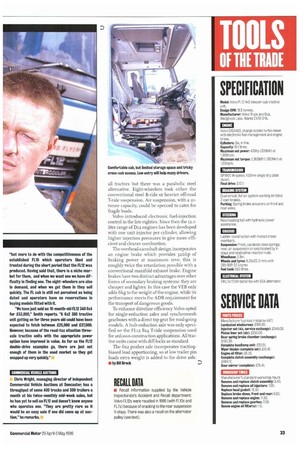BUT WEET T he ar2 had a brief production Tun, from
Page 33

Page 35

If you've noticed an error in this article please click here to report it so we can fix it.
1995 to 1998, while serving as a bridge between two generations of Volvo trucks. It combined the FLici cab from the eighties with the nineties' 12litre driveline, used originally in the FH and later in the FM. FI.J2 tractors were available as 4x2s, 6x2s and 6x4s rated at 380 and 42.ohp; but the FLr2 was more commonly specified as an eight-legger rated at 340 or 38ohp. There are even a few 38ohp 4x2 rigids in use as drawbar prime movers.
All rigid FLIz chassis came with the Volvo engine brake as standard; it was an option on tractive units. Trucks with the 38ohp engine took the R or S Rr7o o nine/14-speed synchromesh gearbox—the SRi9oo 14speed synchromesh box was reserved for 420 models. Volvo's automated mechanical Ceartronic transmission could be specified on 3.4m and 3.8m 4x2 and 3.9m 6x2 pushert axle tractors; the fully automatic Powertronic was reserved as an option for double-drive 8 units and rigid chassis.
The standard front aide on all tractive units 5 was rated at 6.7 tonnes, while a 7.5-tonne axle (standard at the front of 8x4s) was offered as an option. An &a-tonne front axle was also ,< available on rigid chassis.
The 4x2 FL12 tractor's single rear axle was originally plated at ro.5 tonnes but a singletyred pusher axle raised the capacity at the rear to r7.3 tonnes. However, since the advent of higher weights, the 13-tonne design capacity drive axle will easily go to 11.5 tonnes. And depending on tyres, the 6x2 has a maximum back bogie rating of 19 tonnes. All doubledrive models were fitted with two 9.5-tonne axles with inter-axle and cross-axle differentials, giving a combined capacity of19 tonnes.
Air suspension was standard at the rear of all tractors but there was a parabolic steel alternative. Eight-wheelers took either the conventional steel B-ride or heavier off-road T-ride suspension. Air suspension, with a astonne capacity, could be specced to cater for fragile loads.
Volvo introduced electronic fuel-injection control in the late eighties. Since then the 12.1litre range of Diz engines has been developed with one unit injector per cylinder, allowing higher injection pressures to give more efficient and cleaner combustion.
The overhead-camshaft design incorporates an engine brake which provides 320hp of braking power at maximum revs; this is roughly twice the retardation possible with a conventional manifold exhaust brake. Engine brakes have two distinct advantages over other forms of secondary braking systems: they are cheaper and lighter. In this case the VEB only adds 6kg to the weight of the engine, while its performance meets the AD R requirement for the transport of dangerous goods.
To enhance driveline efficiency Volvo opted for single-reduction axles and synchromesh gearboxes with a direct top gear for road-going models. A hub-reduction axle was only specified on the FLI2 8x4 T-ride suspension used for arduous construction applications. All tractive units came with duff-locks as standard The 6x2 pusher axle incorporates tractionbiased load apportioning, so at low trailer pin loads extra weight is added to the drive axle.
• by Mli Brook




















































































































